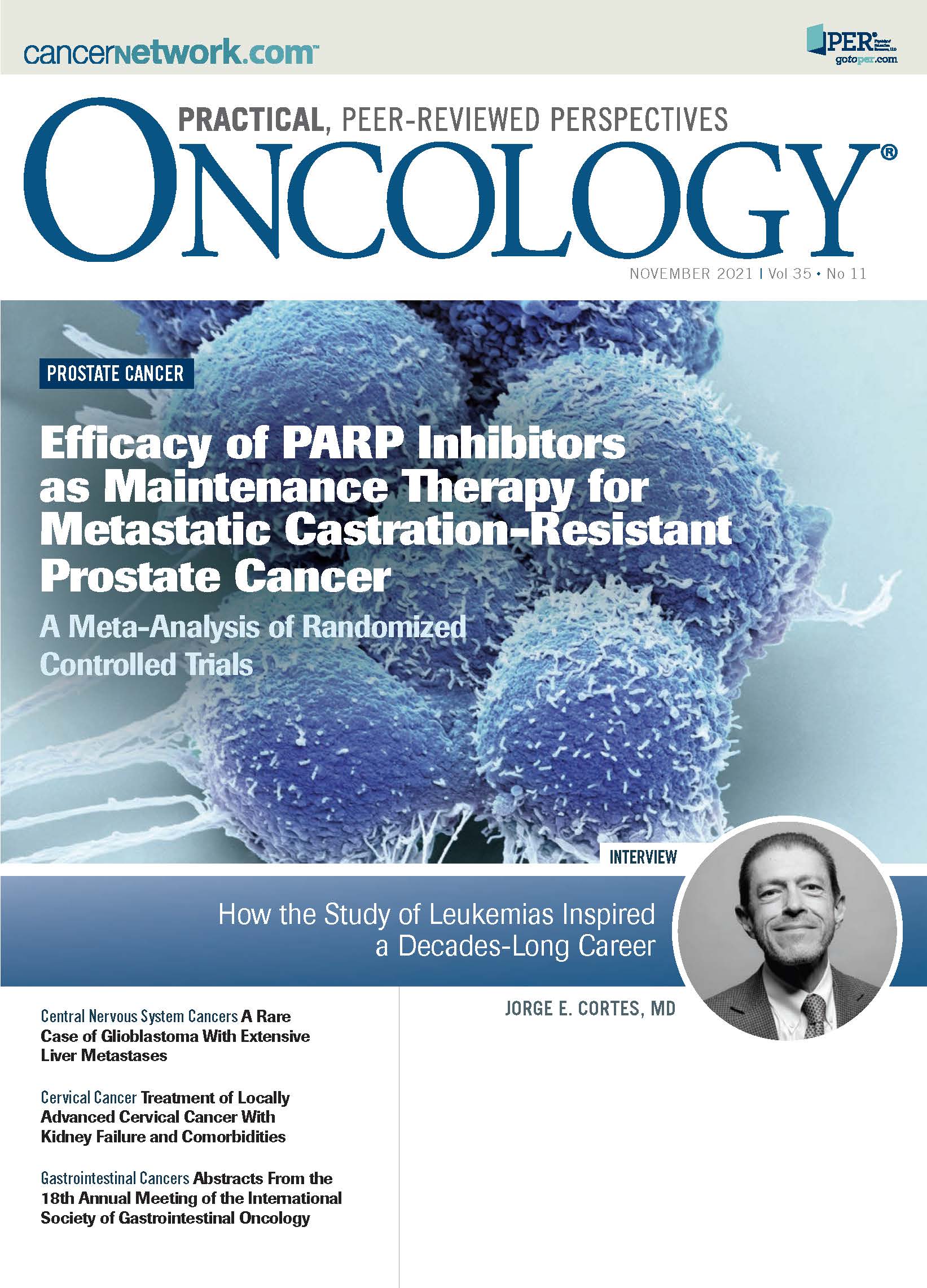Treatment of Locally Advanced Cervical Cancer With Kidney Failure and Comorbidities
In this edition of Clinical Quandaries Eder A. Arango Bravo, MD, and colleagues present a 63 year old woman who has cervical cancer with kidney failure and additional comorbidities.
Oncology (Williston Park). 2021;35(11):741-745.
DOI: 10.46883/ONC.2021.3511.0741
A woman aged 63 years presented at the gynecological oncology outpatient clinic with the following medical history: smoking history (smoking index of 10); systemic arterial hypertension diagnosed 6 years ago; menarche at 16 years; menopause at 52 years; 4 pregnancies, 4 deliveries; beginning of active sexual life at 18 years; 3 sexual partners; and no early cancer detection method in her life. Her performance status per ECOG criteria was 1. The patient presented with transvaginal bleeding with 5 months of evolution. Upon physical exploration, a 5 x 5 cm tumor in the cervix was detected, with the following characteristics: exophytic, friable, bleeding, with invasion to the lower third of the vagina, affection to the cul-de-sac and parametria, and bilaterally fixed to the pelvic wall. A biopsy of the cervix showed moderately differentiated invasive squamous cell carcinoma.
Laboratory studies revealed the following: hemoglobin 6.7 g/dl (grade 3 anemia); creatinine 5.07 mg/dl; glomerular filtration rate (GFR) 9 ml/min/1.73 m2, estimated by the Chronic Kidney Disease Epidemiology Collaboration formula; and blood urea nitrogen (BUN) 40 mg/dl.
Basal PET-CT scan revealed an irregular, heterogeneous cervix. The lesion measured 48 x 59 mm and extended to the vagina, with a maximum standard unit value (SUVmax) of 12.2 and metabolic tumor volume (MTV) of 36.8 cm3. The scan also revealed lymphadenopathy of the left external iliac chain with the following dimensions: 13 mm, SUVmax of 9.4, and MTV of 1.58 cm3; left common iliac adenopathy of 10 mm, SUVmax of 4.2, and MTV of 2.49 cm3; and bilateral hydronephrosis (Figure 1).
FIGURE 1. Baseline PET-CT Scan (A) Local metabolic
activity in the cervix. The lesion measured 48 x 59 mm, extending to the vagina with SUVmax of 12.2 and MTV of 36.8 cm3. Lymphadenopathy of the left external iliac chain measured 13 mm with SUVmax of 9.4 and MTV of 1.58 cm3. Left common iliac adenopathy measured 10 mm with SUVmax of 4.2 and MTV of 2.49 cm3. (B) The presence of bilateral renal ectasia is evidenced. MTV, metabolic tumor volume; SUVmax, maximum standard unit value.
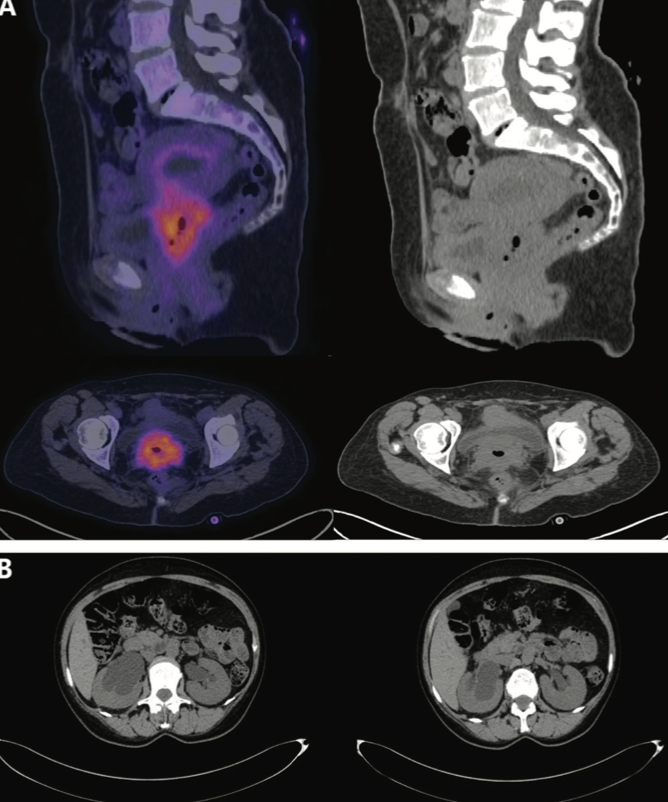
MRI scan of the pelvis revealed a neoformation in the cervix of irregular morphology and heterogeneous intensity. It had the following dimensions: 60 mm (transverse) x
41 mm (anteroposterior) x 47 mm (longitudinal). The lesion infiltrated the lower third of the uterus, conditioning obliteration of the internal cervical orifice. The lesion extended to the lower third of the vagina and presented a loss of interface with the posterior bladder wall and bilateral involvement of the ureterovesical junction; it also presented a loss of the interface with the lower third of the rectum and extended toward the mesorectal fascia. Based on these findings, the patient was diagnosed with cervical cancer (CC) clinical stage IVA.
The patient was hospitalized because of acute kidney injury stage 3. The urology service performed a cystoscopy without the possibility of placing a double-J catheter and decided to place bilateral nephrostomies instead. The patient also received a transfusion of 3 globular packages. Subsequently, 10 days after the placement of nephrostomies, the laboratory reported the following results: creatinine 1.85 mg/dl, GFR 29 ml/min/1.73 m2, BUN 14 mg/dl, and hemoglobin 9.9 g/dl.
Discussion
CC represents a public health problem worldwide; it is the fourth most frequently diagnosed cancer and the fourth leading cause of cancer death in women, with 604,127 new cases per year and 341,831 deaths, according to the Globocan 2020 report.1 In the United States, approximately 14,500 new cases of invasive CC and 4300 cancer-related deaths occur each year. CC is the third most common cancer diagnosis and cause of death among gynecologic cancers in the United States.2 In Mexico, it represents the second leading cause of cancer in women, with 9439 cases per year, and it is the second leading cause of death among women, with 4335 deaths. Additionally, in Mexico, more than 70% of the patients with CC are diagnosed with locally advanced disease (stage IB3 to IVA).1,3
Rates of obstructive uropathy and hydronephrosis in CC vary between 14% and 44.2%. Without therapeutic intervention, obstructive uropathy leads to uremic syndrome and then to renal failure and death.4-6 Importantly, FIGO stage is among the main prognostic factors in CC, impacting mortality and overall survival (OS). In locally advanced stages IIIB, IIIC2, and IVA, clinical studies have demonstrated that unilateral and bilateral hydronephrosis are predictors of mortality and poor prognostic factors for survival. Compared with OS in patients without hydronephrosis (68 months), OS in patients with unilateral hydronephrosis is 27 months, and OS in patients with bilateral hydronephrosis is 12 months (P = .0001).7,8 Rose et al conducted a retrospective analysis of 4 clinical trials that included patients in clinical stage IIIB stratified into 3 subgroups: (1) patients without hydronephrosis, (2) patients with hydronephrosis and urinary tract diversion (retrograde ureteral catheter or nephrostomy catheter), and (3) patients with hydronephrosis without urinary tract diversion. The authors showed that patients in group 1 had the most favorable outcomes, followed by patients in group 2, and patients in group 3 had the worst outcome. Results demonstrated that patients from groups 1, 2, and 3 had an OS of 70 months, 34 months, and 17 months, respectively (P = .0078); their PFS was 48 months, 18 months, and 10 months, respectively, (P = .019). Therefore, Rose et al concluded that hydronephrosis without urinary tract diversion had a negative effect on OS and PFS in this group of patients.6
Treatment options for ureteral obstruction are diverse, including the insertion of a retrograde ureteral stent or the performance of an antegrade percutaneous nephrostomy with or without a previous insertion of an antegrade stent. We thoroughly reviewed the management of ureteral obstruction stemming from both benign and malignant etiologies. Hsu et al have recommended antegrade percutaneous nephrostomy placement preferably in the following scenarios: when it is impossible to place a retrograde ureteral stent; in the presence of lower urinary tract infection, sepsis, anatomical deformity, or bleeding; when the ureteral compression is associated with malignant neoplasia; or the ureteral obstruction segment is more extensive than 3 cm.9 Antegrade percutaneous nephrostomy is an effective method of diversion in patients with ureteral obstruction secondary to advanced malignant neoplasms involving the urinary bladder. Thus, percutaneous drainage remains an option and is almost always technically satisfactory. It is currently the recommended urinary diversion given its minimal morbidity and mortality.9 However, retrograde ureteral stenting is not feasible for more than 70% of patients with obstructive malignancy. For this reason, the initial attempt to place a retrograde ureteral stent on the patient was unsuccessful, and the derivation of the ureteral obstruction with bilateral nephrostomy catheters was necessary.
On the other hand, in locally advanced disease (stages IB3-IVA) in which renal, hematological, and liver functions are not compromised, we recommend option A, the standard treatment consisting of concomitant CT-RT weekly with cisplatin at a dosage of 40 mg/m2. In the 1990s, 5 randomized clinical trials jointly demonstrated that concomitant CT-RT with cisplatin led to better outcomes in local control of the disease. These reported a 30% to 50% reduction of recurrence and 6% to 15% improvement in OS compared with radiotherapy (RT) alone (treatment option B) or RT with hydroxyurea, which was the standard treatment at the time. Based on the evidence from the trials mentioned above, the National Cancer Institute of Canada issued an alert in 1999 that changed the clinical treatment practice for locally advanced CC worldwide.10-14
A meta-analysis published in 2008 aimed to evaluate individual patient data to obtain a time-to-event analysis of OS, locoregional disease-free survival (DFS), and metastasis-free survival, among other outcomes.15 This meta-analysis confirmed the benefit of treatment option A, with an HR of 0.81 for OS and 0.78 for DFS. Authors observed a 5-year absolute improvement of 6% in OS and 8% in DFS; the benefit was more significant in FIGO stages I-II, up to 10%, compared with 3% in FIGO stages III/IVA.15 More recently, in 2017, another meta-analysis confirmed the same findings, affirming the benefit of concomitant treatment with cisplatin. Hence, treatment option A remains the standard for locally advanced CC.16 However, deterioration of renal function limits the use of this drug since nephrotoxicity is the most common adverse effect associated with cisplatin.17
In this case, our patient would be categorized in the group with locally advanced disease (stages IIIB, IIIC2, and IVA) who present with bilateral hydronephrosis, acute kidney injury, and a frank contraindication for the use of cisplatin (14% to 44% of patients). International guidelines for dose adjustment have been created by the Royal College of Radiologists. They suggest a full dose of cisplatin when the GFR is greater than 50 ml/min/1.73 m2, a proportional reduction of the dose if the GFR is between 30 and 50 ml/min/1.73 m2, and the omission of cisplatin if the GFR is lower than 30 ml/min/1.73 m2.18 A stricter approach has been proposed by the British Columbia Cancer Agency, suggesting the administration of 75% of the standard dose of cisplatin if the GFR ranges from 45 to 59 ml/min/1.73 m2 and the omission of the drug when the GFR is lower than 45 ml/min/1.73 m2.19 The National Comprehensive Cancer Network guideline states that cisplatin should not be used in patients with cancer who have a GFR lower than 60 ml/min/1.73 m2 and suggests the use of carboplatin instead of cisplatin.20
For years, this group of patients with CC (stages IIIB, IIIC2, or IVA) with hydronephrosis have been treated with RT followed by brachytherapy (treatment option B), with a benefit in DFS at 5 years of 26% and 10 years of 21%,21 even though the advantage and superiority of concomitant CT-RT have been established.15 In 2018, a retrospective analysis compared cisplatin with RT (treatment option A) vs RT alone (treatment option B) in a geriatric population of patients with cervical cancer and comorbidities. Results showed that cancer-specific mortality at 5 years in the group treated with RT was 39% compared with 31% in the group treated with concomitant CT-RT; that is, patients treated only with RT, option B, had higher mortality compared with those who received complete treatment, option A.22 Therefore, treatment option B, applying only RT to our patient, would not have been a good selection.
On the other hand, treatment option C, best supportive care (palliative care), is an appropriate treatment option for patients with any of the following characteristics: metastatic or advanced disease; high risk of short-term morbidity and mortality; poor prognosis; poor performance status (ECOG 3 or 4); uncontrolled disease symptoms that are not manageable with systemic treatment; or who are not candidates to receive another line of treatment because of greater risk and limited benefit due to treatment-associated toxicity.23,24 In this case, we did not consider therapeutic option C because this patient had locally advanced disease, was never treated for cancer, and had good performance status.
We propose that RT alone (option B) or best supportive care (option C) are not acceptable treatment options for patients with CC in whom cisplatin is contraindicated. Studies demonstrate the usefulness of other drugs in concomitance with RT.
Such is the case of gemcitabine (treatment option D). In vitro studies demonstrated its remarkable radiosensitizing potential in CC cell lines.25 Preclinical research carried out by Hernández et al confirmed these findings. They evaluated the use of gemcitabine in micromolar doses and showed that the drug is cytotoxic in 6 different cervical carcinoma cell lines (INBL, CALO, SIHA, HeLa, C33, and CASKI); authors observed the same effect at nanomolar concentrations in HeLa cells.26 Additionally, a study by Venook et al evaluated the pharmacokinetics of gemcitabine. Patients with solid tumors who had progressed to at least 1 or more lines of treatment with hepatic or renal dysfunction received different doses of gemcitabine ranging from 650 to 900 mg/m2. The authors found that patients with high creatinine levels (1.6-3.2 mg/dl) tolerated gemcitabine without increasing the renal toxicity profile.27
Another study by Pattaranutaporn et al evaluated patients with stage IIIB CC who had an adequate renal function and were treated with gemcitabine at a weekly dose of 300 mg/m2 in concomitance with pelvic RT (option D). The authors reported a complete clinical response rate of 89%, with a tolerable and manageable toxicity profile.28 This evidence led to a pilot study carried out by Cetina et al that included 8 patients with clinical stage IIIB and 1 patient with stage IIIC2 CC restaged according to FIGO 2018. Patients had obstructive uropathy and renal failure, making the use of cisplatin contraindicated. Patients received treatment option D, 300 mg/m2 of gemcitabine weekly concomitantly with RT followed by brachytherapy. The study showed that after treatment, all patients had restored creatinine levels. Furthermore, patients reached a complete clinical response rate of 89%, with a tolerable and manageable toxicity profile at hematological and gastrointestinal levels. Essential to note is that the follow-up time was a mean of 11 months in this study.29
Kundu et al compared 150 mg/m2 of gemcitabine (option D) vs 40 mg/m2 of cisplatin (option A) in concomitance with RT followed by brachytherapy in a randomized phase 2 study conducted in patients with locally advanced CC who had adequate renal function. Results demonstrated that patients who received cisplatin and patients who received gemcitabine responded similarly (55% vs 48.9%, respectively; P = .67). Even so, the study did not compare gemcitabine at a dose of 300 mg/m2, which has shown greater efficacy in locally advanced CC.30
Finally, treatment option E was neoadjuvant chemotherapy treatment. Numerous clinical trials have evaluated its efficacy in locally advanced CC with unfavorable results. Recently, Gupta et al demonstrated that concomitant CT-RT (option A) had a more significant benefit in DFS at 5 years compared with neoadjuvant chemotherapy with carboplatin and paclitaxel (option E) followed by surgery, with an absolute difference of 7.4% between groups. Subgroup analysis suggested that the main benefit of concomitant CT-RT was in patients with stage IIB CC; the results showed no difference in OS between the groups. Clinical trials (interLACE, CIRCE) are currently evaluating the efficacy of neoadjuvant chemotherapy, followed by CT-RT with cisplatin, in locally advanced disease.31 No conclusive results are available yet, so option E is not a standard of treatment for patients with locally advanced CC.
Case Outcome
Based on the evidence presented in this work, we treated the patient with option D, concomitant CT-RT, with 300 mg/m2 of gemcitabine weekly. She received 3-dimensional conformal radiation therapy, which consisted of 50 Gy in 25 fractions to the pelvis plus a boost of 10 Gy in 5 fractions to parametria and obturator nodes. Her treatment concluded with high-dose brachytherapy in 4 applications of 6.5 Gy. The patient received 5 weekly chemotherapy cycles; the third cycle dose was reduced by 25% due to hematological toxicity (grade 2 neutropenia; grade 3 thrombocytopenia). She also presented gastrointestinal toxicity (grade 1 diarrhea; grade 2 abdominal pain) with adequate control. It is important to note that during the weekly chemotherapy cycles, the patient’s GFR remained above 50 ml/min/1.73 m2 since the second application, as shown in the Table.
TABLE. Description of Patient’s Serum Creatinine Levels and GFRa Throughout Treatment
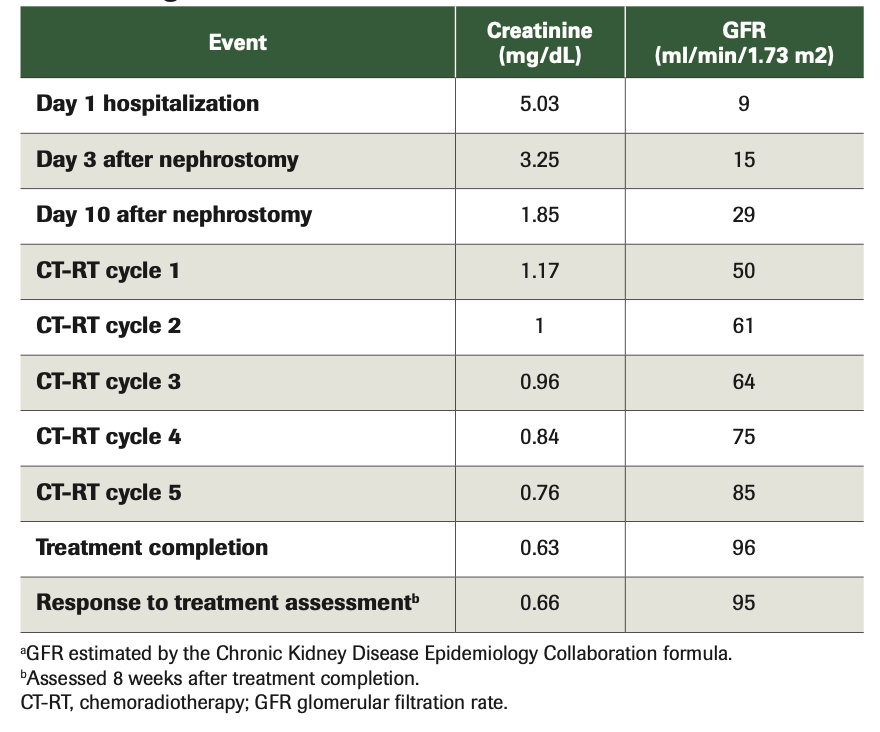
Eight weeks after the end of brachytherapy, a clinical response assessment demonstrated a complete response; however, both the PET-CT and MRI imaging revealed a partial response, as shown in Figures 2 and 3. In addition, the cervical cytology analysis revealed reactive cell changes associated with RT, and a vaginal dome biopsy evidenced extensive necrosis without viable cells in the sample. The patient is currently in a 24-month disease-free period and under surveillance by the medical oncology department.
FIGURE 2. Response Assessment Imaging (A) Pelvic MRI image (sagittal section, without contrast). The image on the left corresponds to the baseline diagnosis; the image on the right corresponds to the response assessment 8 weeks after treatment completion. (B) Pelvic MRI image (axial section, without contrast). The image on the left corresponds to the baseline diagnosis; the image on the right corresponds to the response assessment 8 weeks after treatment completion.
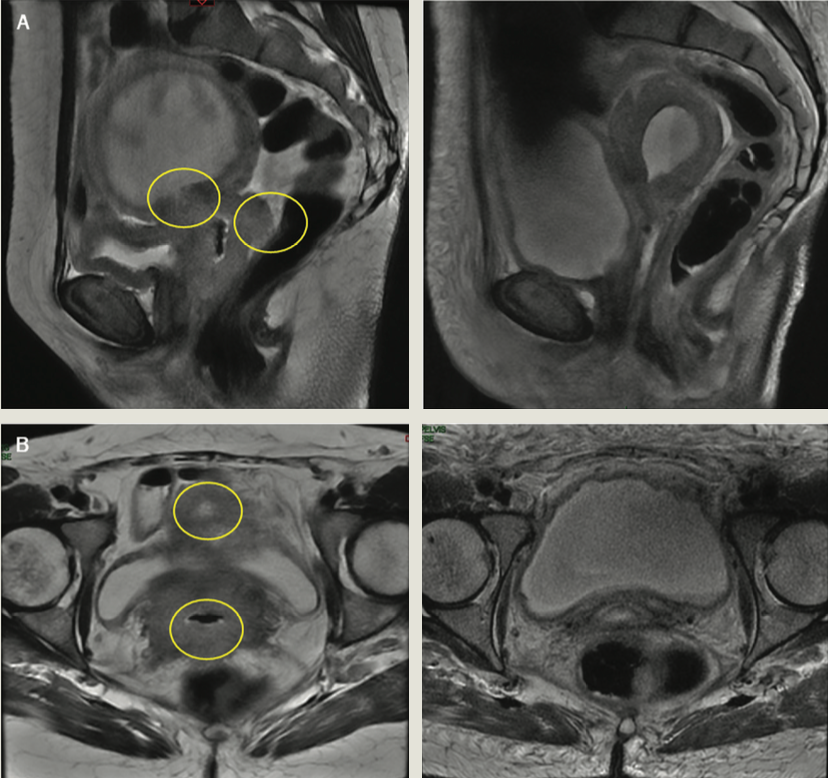
FIGURE 3. Response Assessment PET-CT Scan. The image reveals the absence of metabolic uptake.
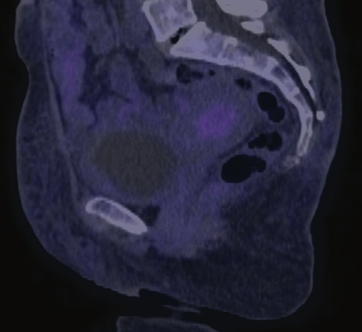
Disclosure: Authors declare they have no conflict of interest nor financial interest with the manufacturer of any product mentioned in this article.
AUTHOR AFFILIATIONS:
¹Department of Clinical Research, Instituto Nacional de Cancerología, Mexico City, Mexico.
²Department of Medical Oncology, Instituto Nacional de Cancerología, Mexico City, Mexico.
³Integral Program for the Care of Locally Advanced and Metastatic Cervical Cancer (MICAELA), Instituto Nacional de Cancerología, Mexico City, Mexico.
4Investigadores por México, Consejo Nacional de Ciencia y Tecnología (CONACYT), Mexico City, Mexico.
5Integral Accessibility Program for the Care of Ovarian and Endometrial Cancer (COE), Instituto Nacional de Cancerología, Mexico City, Mexico.
6Department of Oncology, Hospital Médica Sur, Mexico City, Mexico.
ABOUT THE SERIES EDITORS:
Maria T. Bourlon, MD, is associate professor, head Urologic Oncology Clinic; national researcher, Instituto Nacional de Ciencias Médicas y Nutrición Salvador Zubirán, Mexico City, Mexico. She is also a member of ASCO’s IDEA Working Group.
E. David Crawford, MD, is chairman, Prostate Conditions Education Council; editor in chief, Grand Rounds in Urology; and professor of Urology, University of California San Diego, La Jolla.
References
- Sung H, Ferlay J, Siegel RL, et al. Global cancer statistics 2020: GLOBOCAN estimates of incidence and mortality worldwide for 36 cancers in 185 countries. CA Cancer J Clin. 2021;71(3):209-249. doi:10.3322/caac.21660
- Siegel RL, Miller KD, Fuchs HE, Jemal A. Cancer statistics, 2021. CA Cancer J Clin. 2021;71(1):7-33. doi:10.3322/caac.21654
- Meneses-García A, Ruiz-Godoy LM, Beltrán-Ortega A, et al. Principales neoplasias malignas en México y su distribución geográfica (1993-2002). Rev Investig Clin. 2012;64:322-329.
- Chao KS, Leung WM, Grigsby PW, Mutch DG, Herzog T, Perez CA. The clinical implications of hydronephrosis and the level of ureteral obstruction in stage IIIB cervical cancer. Int J Radiat Oncol Biol Phys. 1998;40(5):1095-1100. doi:10.1016/S0360-3016(97)00899-7
- Pradhan TS, Duan H, Katsoulakis E, Salame G, Lee Y-C, Abulafia O. Hydronephrosis as a prognostic indicator of survival in advanced cervix cancer. Int J Gynecol Cancer. 2011;21(6):1091-1096. doi:10.1097/IGC.0b013e31821cabc8
- Rose PG, Ali S, Whitney CW, Lanciano R, Stehman FB. Impact of hydronephrosis on outcome of stage IIIB cervical cancer patients with disease limited to the pelvis, treated with radiation and concurrent chemotherapy: a Gynecologic Oncology Group study. Gynecol Oncol. 2010;117(2):270-275. doi:10.1016/j.ygyno.2010.01.045
- Patel K, Foster NR, Kumar A, et al. Hydronephrosis in patients with cervical cancer: an assessment of morbidity and survival. Supportive Care Cancer. 2015;23(5):1303-1309. doi:10.1007/s00520-014-2482-y
- Goklu MR, Seckin KD, Togrul C, et al. Effect of hydronephrosis on survival in advanced stage cervical cancer. Asian Pac J Cancer Prev. 2015;16(10):4219-4222. doi:10.7314/APJCP.2015.16.10.4219
- Hsu L, Li H, Pucheril D, et al. Use of percutaneous nephrostomy and ureteral stenting in management of ureteral obstruction. World J Nephrol. 2016;5(2):172-181. doi:10.5527/wjn.v5.i2.172
- Whitney CW, Sause W, Bundy BN, et al. Randomized comparison of fluorouracil plus cisplatin versus hydroxyurea as an adjunct to radiation therapy in stage IIB-IVA carcinoma of the cervix with negative para-aortic lymph nodes: a Gynecologic Oncology Group and Southwest Oncology Group study. J Clin Oncol. 1999;17(5):1339-1348. doi:10.1200/JCO.1999.17.5.1339
- Rose PG, Bundy BN, Watkins EB, et al. Concurrent cisplatin-based radiotherapy and chemotherapy for locally advanced cervical cancer. N Engl J Med. 1999;340(15):1144-1153. doi:10.1056/NEJM199904153401502
- Morris M, Eifel PJ, Lu J, et al. Pelvic radiation with concurrent chemotherapy compared with pelvic and para-aortic radiation for high-risk cervical cancer. N Engl J Med. 1999;340(15):1137-1143. doi:10.1056/NEJM199904153401501
- Keys HM, Bundy BN, Stehman FB, et al. Cisplatin, radiation, and adjuvant hysterectomy compared with radiation and adjuvant hysterectomy for bulky stage Ib cervical carcinoma. N Engl J Med. 1999;340(15):1154-1161. doi:10.1056/NEJM199904153401503
- Peters WA III, Liu PY, Barrett RJ II, et al. Concurrent chemotherapy and pelvic radiation therapy compared with pelvic radiation therapy alone as adjuvant therapy after radical surgery in high-risk early-stage cancer of the cervix. J Clin Oncol. 2000;18(8):1606-1613. doi:10.1200/JCO.2000.18.8.1606
- CRT for Cervical Cancer Meta-Analysis Collaboration. Reducing uncertainties about the effects of chemoradiotherapy for cervical cancer: a systematic review and meta-analysis of individual patient data from 18 randomized trials. J Clin Oncol. 2008;26(35):5802-5812. doi:10.1200/JCO.2008.16.4368
- Datta NR, Stutz E, Liu M, et al. Concurrent chemo-radiotherapy vs. radiotherapy alone in locally advanced cervix cancer: a systematic review and meta-analysis. Gynecol Oncol. 2017;145(2):374-385. doi:10.1016/j.ygyno.2017.01.033
- Perazella MA. Onco-nephrology: renal toxicities of chemotherapeutic agents. Clin J Am Soc Nephrol. 2012;7(10):1713-1721. doi:10.2215/CJN.02780312
- Royal College of Radiologists’ Clinical Oncology Information Network. Guidelines for cytotoxic chemotherapy in adults. a document for local expert groups in the United Kingdom preparing chemotherapy policy documents. Clinical Oncol (R Coll Radiol). 2001;13(1):s209-s248.
- BC Cancer Drug Manual. Drug name: Cisplatin. BC Cancer Agency. Developed 1994. Updated 2019. Accessed August 30, 2021. https://bit.ly/3jfFjPY
- NCCN. Clinical Practice Guidelines in Oncology. Bladder cancer, version 4.2021. Accessed October 13, 2021. https://bit.ly/3AT4Pk3
- Yeung AR, Amdur RJ, Morris CG, Morgan LS, Mendenhall WM. Long-term outcome after radiotherapy for FIGO stage IIIB and IVA carcinoma of the cervix. Int J Radiat Oncol Biol Phys. 2007;67(5):1445-1450. doi:10.1016/j.ijrobp.2006.11.013
- Xiang M, Kidd EA. Benefit of cisplatin with definitive radiotherapy in older women with cervical cancer. J Natl Compr Canc Netw. 2019;17(8):969-975. doi:10.6004/jnccn.2019.7289
- NCCN. Clinical Practice Guidelines in Oncology. Palliative care, version 2.2021. Accessed August 30, 2021. https://bit.ly/3BULtfJ
- Lefkowits C, Binstock AB, Courtney-Brooks M, et al. Predictors of palliative care consultation on an inpatient gynecologic oncology service: are we following ASCO recommendations? Gynecol Oncol. 2014;133(2):319-325. doi:10.1016/j.ygyno.2014.02.031
- Pauwels B, Korst AEC, Lardon F, Vermorken JB. Combined modality therapy of gemcitabine and radiation. Oncologist. 2005;10(1):34-51. doi:10.1634/theoncologist.10-1-34
- Hernández P, Olivera P, Dueñas-Gonzalez A, et al. Gemcitabine activity in cervical cancer cell lines. Cancer Chemother Pharmacol. 2001;48(6):488-492. doi:10.1007/s002800100370
- Venook AP, Egorin MJ, Rosner GL, et al. Phase I and pharmacokinetic trial of gemcitabine in patients with hepatic or renal dysfunction: Cancer and Leukemia Group B 9565. J Clin Oncol. 2000;18(14):2780-2787. doi:10.1200/JCO.2000.18.14.2780
- Pattaranutaporn P, Thirapakawong C, Chansilpa Y, Therasakvichya S, Ieumwananontachai N, Thephamongkhol K. Phase II study of concurrent gemcitabine and radiotherapy in locally advanced stage IIIB cervical carcinoma. Gynecol Oncol. 2001;81(3):404-407. doi:10.1006/gyno.2001.6197
- Cetina L, Rivera L, Candelaria M, de la Garza J, Dueñas-González A. Chemoradiation with gemcitabine for cervical cancer in patients with renal failure. Anticancer Drugs. 2004;15(8):761-766. doi:10.1097/00001813-200409000-00004
- Kundu S, Basu S, Acharya S, Dastidar A, Roy A. Chemoradiation in locally advanced cervical cancer : a randomized trial. Indian J Med Paediatr Oncol. 2008;29(4):12. doi:10.4103/0971-5851.51399
- Gupta S, Maheshwari A, Parab P, et al. Neoadjuvant chemotherapy followed by radical surgery versus concomitant chemotherapy and radiotherapy in patients with stage IB2, IIA, or IIB squamous cervical cancer: a randomized controlled trial. J Clin Oncol. 2018;36(16):1548-1555. doi:10.1200/JCO.2017.75.9985
